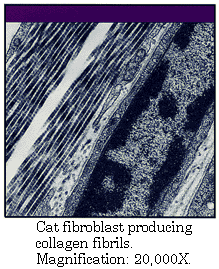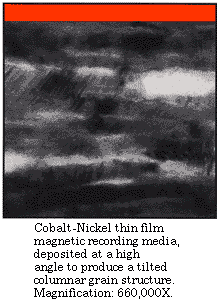Processing Films
After the films have been exposed and removed, they must be properly processed under the appropriate darkroom conditions. Whatever your need, Electron Micrography Products allow you to obtain high-quality images for a variety of specimens and instrument conditions:
Electron Microscope Film 4489 - produces high-quality images without special processing procedures. Use for general purpose applications.
Electron Image Film SO-163 - extremely versatile, they can be processed for maximum, intermediate, or minimum speed by adjusting the development conditions.
Machine Processing
The trend in processing film is toward mechanization. By this means, large quantities of film can be processed with an immense saving in time, labor, and working space. Such equipment could be used in conjunction with other departments using photography to amortize the initial cost. The savings in time may justify the cost of a machine in cases where smaller quantities of negatives are needed in a minimum length of time.
Most film processors deliver processed and dried negatives in a matter of minutes. For information about mechanized processing, contact your Electron Microscope Products Dealer.
Processing for Image Stability
Your micrograph negatives should have a satisfactory life-span if you follow the guidelines in this publication. For more extended life and maximum stability, you must process your micrographs according to very specific procedures and with special precautions. When mixing chemical solutions, measure accurately and avoid contamination of one solution with another. Maintain a uniform temperature throughout processing, and test your micrograph negatives to assure that your processing effectively removed fixer and unwanted silver compounds.

Development Guidelines and Procedures
Besides exposure, four main considerations govern the density, contrast, and uniformity of the negative. These factors are: the type of developer, the developer temperature, the length of development, and the agitation during development.
EM films should be developed with continuous agitation for the time listed in Table C: Developing EM Films. The intermediate speed is recommended for general applications with an intermediate signal to noise ratio (S/N). The minimum speed should be used with stable specimens with maximum S/N results. The maximum speed will yield the best results for unstable specimens with low S/N results.
Three of the development conditions shown in Table C: Developing Films require the use of Anti-Fog, No. 1 (benzotriazole). Because benzotriazole is only slightly soluble in water or developer solution, the most convenient method for adding it to freshly prepared developer solutions is to use a stock solution of Anti-Fog, No. 1 in ethylene glycol.
To prepare a stock solution, you will need:
- 700.0 ml of ethylene glycol (high purity)
- 166.7 gm of Anti-Fog,
No.1 (benzotriazole) in powder form*
*Do not use the tablet form. Each tablet contains only 0.03 gram of benzotriazole.
For this solution alone, over 5,500 tablets (110 50-tablet bottles) would be needed.
Warm the ethylene glycol to 120F (49C). Add the Anti-Fog, No.1 and stir until completely dissolved. Cool to 75F (24C). Add ethylene glycol to make a total volume of 1 litre and stir until the solution is uniform. If the stock solution is stored in a stoppered brown bottle, it may be kept indefinitely. For each gram of Anti-Fog, No. 1 required, use 6 ml of the prepared stock solution.

Tank Development (with intermittent nitrogen-burst agitation)
With the nitrogen-burst agitation unit set for about 2-second bursts at 8-second intervals, start the timer. Smoothly and carefully lower the rack or hangers into the developer solution.
Allow the films to remain undisturbed (except by the automatic agitation from the nitrogen bursts) until development is complete. Lift the rack or hangers from the developer. Allow excess developer to drain for 1 or 2 seconds, and then transfer the rack or hangers to the next tank.
The pressure of the nitrogen gas should be sufficient to produce with each burst a rise of about 5/8 inch in the level of the developer. It is this rise, not the bubble action, which provides the agitation necessary for uniform development.
Fix and Wash
Testing Fixer for Effectiveness
Fixing solutions should be discarded when films take twice as long to clear as they did in fresh fixer. To test for this, in room light place an unprocessed piece of film (the same type that you plan to process) in water for 1 minute. Then place it in fresh fixer at the same temperature as the water. Note how long it takes for the milkiness to disappear from the negative. Repeat this procedure to test the fixer in use (this fixer should be at the same temperature as the fresh fixer in the first test). If this time is twice the clearing time required in fresh fixer (or longer), the fixer is exhausted and should
TABLE D: Storage Life and Useful Capacities of Solutions
| Solution | Stock Solution in Stoppered Bottle | Storing Life | Working Solution | 3 1/4 X 4 - inch Sheets per Gallon Tank |
|---|---|---|---|---|
| Film Developers | D-19 | 6 months (full) | 1 week (gallon tank) | 100 (gallon tank) |
| 2 months (half full) | ||||
| Fixing Baths | Fixer | 2 months | 1 month (gallon tank) | 600 |
| Rapid Fixer (with hardener) | 2 months | 720 (Mixed 1:3) | ||
| Washing Aids | HYPO Clearing Agent | 3 months | 24 hour (tray) | Without pre-rinse: 300-360 With pre-rinse: 900-1200 |
| PHOTO-FLO | - | 24 hour (tray) |